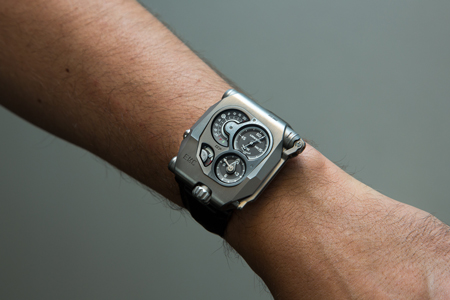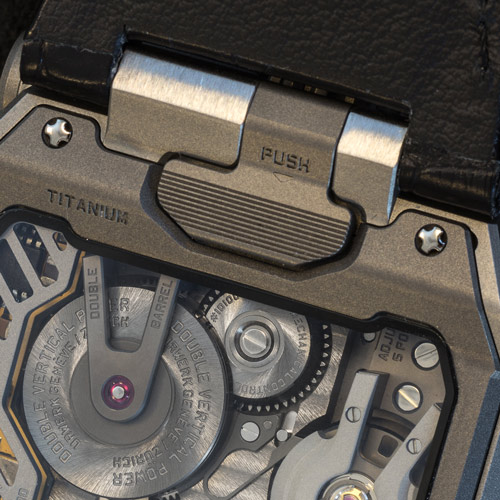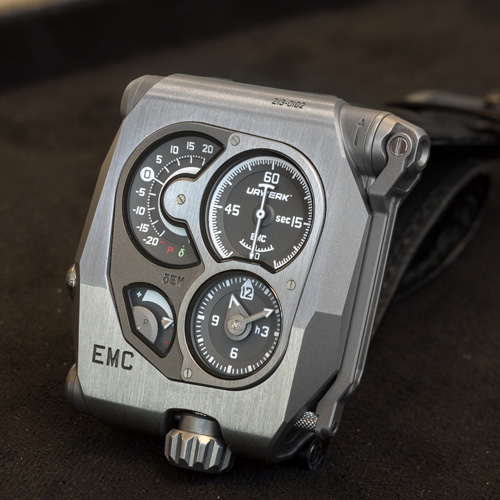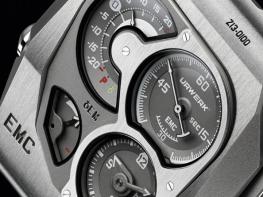The Geneva boutique brand adds a mechanism to measure precision to the movement, allowing the wearer to adjust his or her own timing.
If you’ve ever visited a watchmaker’s workshop, you will know that every well-outfitted watchmaker has a Witschi sitting on the bench. Most consumers probably aren’t quite aware of what this little machine does: it measures the accuracy (the rate) of the watch’s movement, allowing the watchmaker to make adjustments to the balance until the watch satisfies the precision criteria.
The goal of Urwerk’s special research division – known internally as the U-Research Division – in creating the EMC (which stands for Electro Mechanical Control) was to basically provide its owner with an integrated Witschi right in the movement.
“To do this, we had to find a way to give the owner access to one of the vital organs of the watch: the balance spring, which is generally hidden deep inside the movement and thus untouchable,” Felix Baumgartner, co-founder and head watchmaker explains of the idea that visibly excited him. “So, we developed this ‘tool’ to adjust the index assembly, inspired by an instrument that was used long, long ago on a Breguet pocket watch.”
 While the Witschi “listens” to the beat of the mechanical movement to determine its accuracy, the EMC’s movement contains an optical sensor to precisely measure the balance wheel’s rate. “We’ve made a connection between the movement’s ‘heart’ and this new electronic ‘supervisor’,” Baumgartner continues. To fit all of this into the miniscule amount of space available, the watchmakers chose to fit the case to the movement. “With the help of our IT engineer, we came to the conclusion than an optical sensor was the best technical solution for precisely measuring the balance wheel’s rate. It took a while before we came up with the perfect way to connect it to our balance wheel; it looks sort of like a Revox tape, totally flat with three strategically placed holes for measuring.”
While the Witschi “listens” to the beat of the mechanical movement to determine its accuracy, the EMC’s movement contains an optical sensor to precisely measure the balance wheel’s rate. “We’ve made a connection between the movement’s ‘heart’ and this new electronic ‘supervisor’,” Baumgartner continues. To fit all of this into the miniscule amount of space available, the watchmakers chose to fit the case to the movement. “With the help of our IT engineer, we came to the conclusion than an optical sensor was the best technical solution for precisely measuring the balance wheel’s rate. It took a while before we came up with the perfect way to connect it to our balance wheel; it looks sort of like a Revox tape, totally flat with three strategically placed holes for measuring.”
 While the Witschi “listens” to the beat of the mechanical movement to determine its accuracy, the EMC’s movement contains an optical sensor to precisely measure the balance wheel’s rate. “We’ve made a connection between the movement’s ‘heart’ and this new electronic ‘supervisor’,” Baumgartner continues. To fit all of this into the miniscule amount of space available, the watchmakers chose to fit the case to the movement. “With the help of our IT engineer, we came to the conclusion than an optical sensor was the best technical solution for precisely measuring the balance wheel’s rate. It took a while before we came up with the perfect way to connect it to our balance wheel; it looks sort of like a Revox tape, totally flat with three strategically placed holes for measuring.”
While the Witschi “listens” to the beat of the mechanical movement to determine its accuracy, the EMC’s movement contains an optical sensor to precisely measure the balance wheel’s rate. “We’ve made a connection between the movement’s ‘heart’ and this new electronic ‘supervisor’,” Baumgartner continues. To fit all of this into the miniscule amount of space available, the watchmakers chose to fit the case to the movement. “With the help of our IT engineer, we came to the conclusion than an optical sensor was the best technical solution for precisely measuring the balance wheel’s rate. It took a while before we came up with the perfect way to connect it to our balance wheel; it looks sort of like a Revox tape, totally flat with three strategically placed holes for measuring.”
First in-house movement
The development of the EMC, which has taken about six years, is viewed by Baumgartner as a natural development of the work he has done with Urwerk. This first 100-percent in-house caliber, which is regulated within the same tolerances as a C.O.S.C.-certified movement, is a manually wound movement that contains vertically mounted, serially operating twin spring barrels for a full 80 hours of power reserve. This movement, however, has an added electronic element: the artificial intelligence Maxon generator – in other words, a super capacitor – which gets its energy from a manually operated winding crank that folds out from the side of the case.
 Despite all the novel technology squeezed into the 43 x 51 x 15.8 mm titanium and steel case, the finishing remains relatively traditional, including côtes de Genève, micro bead blasting, and polished bevels, even on screw heads.
Despite all the novel technology squeezed into the 43 x 51 x 15.8 mm titanium and steel case, the finishing remains relatively traditional, including côtes de Genève, micro bead blasting, and polished bevels, even on screw heads.
 Despite all the novel technology squeezed into the 43 x 51 x 15.8 mm titanium and steel case, the finishing remains relatively traditional, including côtes de Genève, micro bead blasting, and polished bevels, even on screw heads.
Despite all the novel technology squeezed into the 43 x 51 x 15.8 mm titanium and steel case, the finishing remains relatively traditional, including côtes de Genève, micro bead blasting, and polished bevels, even on screw heads.
How does it work?
The movement is 100 percent fully mechanical despite the electronics integrated for the rate measurement. The dial already reveals some of the EMC’s special powers, emphasizing them by placing the most important functions right on top.
The dial comprises four subdial windows. At the top left, where the eye naturally falls first, the biggest display of the four shows the precision counter, which tells us how accurate the movement is currently performing once the super capacitor has been activated by pushing a button after turning the winding handle between 5 and 15 times. No more turns of the handle are needed to get the super capacitor to full power and 15 turns will keep it charged for a full hour (during which time it can take up to 8 readings if one is so inclined). Once this is done, the owner only needs to push the button on the left, which moves the little hand to the green delta symbol (if it moves there, it means there is enough charge for it to work properly). If it lands on the red “P,” there is not enough power accrued to function. It is important to lay the EMC in a flat position – or at least the same position – every time the owner takes a reading.
 Next to that, at the top right, we see the display of seconds. Like on a chronometer or a regulator, this is an all-important display to determine accuracy. Underneath that, on the bottom right, are the hours and minutes (a secondary determination of time here, yet important for daily life). At bottom left, in the smallest of the four windows, is the power reserve indication, which alerts the wearer when the 80-hour power reserve is almost empty and it is time to wind the watch again.
Next to that, at the top right, we see the display of seconds. Like on a chronometer or a regulator, this is an all-important display to determine accuracy. Underneath that, on the bottom right, are the hours and minutes (a secondary determination of time here, yet important for daily life). At bottom left, in the smallest of the four windows, is the power reserve indication, which alerts the wearer when the 80-hour power reserve is almost empty and it is time to wind the watch again.
 Next to that, at the top right, we see the display of seconds. Like on a chronometer or a regulator, this is an all-important display to determine accuracy. Underneath that, on the bottom right, are the hours and minutes (a secondary determination of time here, yet important for daily life). At bottom left, in the smallest of the four windows, is the power reserve indication, which alerts the wearer when the 80-hour power reserve is almost empty and it is time to wind the watch again.
Next to that, at the top right, we see the display of seconds. Like on a chronometer or a regulator, this is an all-important display to determine accuracy. Underneath that, on the bottom right, are the hours and minutes (a secondary determination of time here, yet important for daily life). At bottom left, in the smallest of the four windows, is the power reserve indication, which alerts the wearer when the 80-hour power reserve is almost empty and it is time to wind the watch again.
Felix Baumgartner explains that the subdial design of the front makes it look especially like an instrument.
And the other side?
On flip side of the EMC, the integrated circuit board for the super capacitor is visible under grill on right side of the movement, which can be viewed through the sapphire crystal case back. On the left side is the crank for winding the capacitor.
 Aside from the unique look of the movement, one other detail becomes apparent to those who look closely: there is a pusher on the lower back bezel, between the lugs. If the wearer pushes down on this, it will click the oversized crown out; a wonderful detail to avoid killing one’s fingernails and another interactive element that not only provides pleasure but also avoids undue wear on the crown, which Urwerk models often experience since their owners tend to like to “show” what their watches are capable of by providing “fast-forward” action of the satellites.
Aside from the unique look of the movement, one other detail becomes apparent to those who look closely: there is a pusher on the lower back bezel, between the lugs. If the wearer pushes down on this, it will click the oversized crown out; a wonderful detail to avoid killing one’s fingernails and another interactive element that not only provides pleasure but also avoids undue wear on the crown, which Urwerk models often experience since their owners tend to like to “show” what their watches are capable of by providing “fast-forward” action of the satellites.
 Aside from the unique look of the movement, one other detail becomes apparent to those who look closely: there is a pusher on the lower back bezel, between the lugs. If the wearer pushes down on this, it will click the oversized crown out; a wonderful detail to avoid killing one’s fingernails and another interactive element that not only provides pleasure but also avoids undue wear on the crown, which Urwerk models often experience since their owners tend to like to “show” what their watches are capable of by providing “fast-forward” action of the satellites.
Aside from the unique look of the movement, one other detail becomes apparent to those who look closely: there is a pusher on the lower back bezel, between the lugs. If the wearer pushes down on this, it will click the oversized crown out; a wonderful detail to avoid killing one’s fingernails and another interactive element that not only provides pleasure but also avoids undue wear on the crown, which Urwerk models often experience since their owners tend to like to “show” what their watches are capable of by providing “fast-forward” action of the satellites.
“I think that the crown of a watch, the interface where the human meets the machine to charge it with his energy, is an essential part that deserves special attention and an accurate design,” explains Martin Frei, co-founding designer of Urwerk. “One reason why Urwerk crowns are massive is to celebrate this moment.”
Looking at the back, one will notice a timing screw at the top; this moves the “hand” just underneath it along a scale underneath for fine tuning. The EMC is delivered with a small screwdriver so that the owner can move that screw in accordance with the readings to make this watch the most accurate it can be.
Baumgartner is very happy with the result of the EMC, which is limited to an almost homeopathic dose of 55 pieces. He feels that the precision of its readings is better than that of a Witschi, accurate time after time.
 If I were to give a piece of advice as to the best way to use it, it would be this: wear the EMC for a couple of weeks and critically observe what its movement gains and loses. Don’t play around with it and show friends, like you might have done with one of the satellite-outfitted models, but really give it the opportunity to show what it can do. The aim should be to adjust its timing to make it the best personal timing for you. Use the capacitor only every couple of weeks and keep a log. But those are just my two cents.
If I were to give a piece of advice as to the best way to use it, it would be this: wear the EMC for a couple of weeks and critically observe what its movement gains and loses. Don’t play around with it and show friends, like you might have done with one of the satellite-outfitted models, but really give it the opportunity to show what it can do. The aim should be to adjust its timing to make it the best personal timing for you. Use the capacitor only every couple of weeks and keep a log. But those are just my two cents.
 If I were to give a piece of advice as to the best way to use it, it would be this: wear the EMC for a couple of weeks and critically observe what its movement gains and loses. Don’t play around with it and show friends, like you might have done with one of the satellite-outfitted models, but really give it the opportunity to show what it can do. The aim should be to adjust its timing to make it the best personal timing for you. Use the capacitor only every couple of weeks and keep a log. But those are just my two cents.
If I were to give a piece of advice as to the best way to use it, it would be this: wear the EMC for a couple of weeks and critically observe what its movement gains and loses. Don’t play around with it and show friends, like you might have done with one of the satellite-outfitted models, but really give it the opportunity to show what it can do. The aim should be to adjust its timing to make it the best personal timing for you. Use the capacitor only every couple of weeks and keep a log. But those are just my two cents.
No, the EMC is not a satellite-construct watch like one has come to expect from Urwerk. It is the next step in the company’s evolution, an exciting mix of man and machine using every element at his or her disposal.
Featured brand





